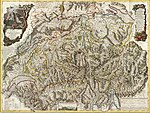History of Switzerland
| History of Switzerland |
|---|
 |
| Early history |
|
| Old Swiss Confederacy |
|
| Transitional period |
|
| Modern history |
|
| Timeline |
| Topical |
|
|
|
Since 1848 the
The
The
The history of Switzerland since 1848 has been largely one of success and prosperity. Industrialisation transformed the traditional agricultural economy, and Swiss neutrality during the World Wars and the success of the banking industry furthered the ascent of Switzerland to its status as one of the world's most stable economies.
Switzerland signed a free-trade agreement with the European Economic Community in 1972 and has participated in the process of European integration by way of bilateral treaties, but it has notably resisted full accession to the European Union (EU) even though its territory almost completely (except for the microstate Liechtenstein) has been surrounded by EU member states since 1995. In 2002, Switzerland joined the United Nations.
Early history
Prehistory
A female who died in about 200 B.C. was found buried in a carved tree trunk during a construction project at the Kern school complex in March 2017 in Aussersihl. Archaeologists revealed that she was approximately 40 years old when she died and likely carried out little physical labor when she was alive. A sheepskin coat, a belt chain, a fancy wool dress, a scarf and a pendant made of glass, and amber beads were also discovered with the woman.[3][4][5]
Antiquity

In 58 BC, the Helvetii tried to evade migratory pressure from

The first Christian bishoprics were founded in the fourth century.
With the
Medieval period
Under the
In the 10th century, as the rule of the Carolingians waned,
In the 12th century, the dukes of
Under the
The extinction of the
Old Confederacy (1300–1798)
Late Medieval period
- 1803 –
- 1979 –
 Jura (secession from Bern)
Jura (secession from Bern) - 1999 – official status of the six Basel-Landschaft)
See also
- Historiography of Switzerland
- History of the Grisons
- History of Zürich
- List of presidents of the Swiss Confederation
- Politics of Switzerland
- Postage stamps and postal history of Switzerland
General:
Notes and references
- ^ "Switzerland's Prehistory: Stone Age, Lake Dwellings". history-switzerland.geschichte-schweiz.ch. Archived from the original on January 3, 2016. Retrieved November 24, 2013.
- swissinfo. Archived from the originalon June 16, 2008. Retrieved September 15, 2007.
- ^ Geggel, Laura (July 30, 2019). "Iron Age Celtic Woman Wearing Fancy Clothes Buried in This 'Tree Coffin' in Switzerland". livescience.com. Archived from the original on April 19, 2020. Retrieved April 5, 2020.
- ^ "Kelte trifft Keltin: Ergebnisse zu einem aussergewöhnlichen Grabfund – Stadt Zürich". www.stadt-zuerich.ch (in German). Archived from the original on May 14, 2020. Retrieved April 5, 2020.
- ^ Solly, Meilan. "This Iron Age Celtic Woman Was Buried in a Hollowed-Out Tree Trunk". Smithsonian Magazine. Archived from the original on August 9, 2020. Retrieved April 5, 2020.
- ^ ISBN 978-1-315-06303-4. Archivedfrom the original on January 16, 2023. Retrieved August 5, 2022.
- ^ Hughes, Christopher, Switzerland (London, 1975) p.66 ff, 84.
- ^ Bonjour, Edgar et al. A short History of Switzerland (Oxford, 1952) p.191.
- ^ Marc H. Lerner, "The Helvetic Republic: An Ambivalent Reception of French Revolutionary Liberty," French History (2004) 18#1 pp 50-75.
- ^ R.R. Palmer, The Age of the Democratic Revolution 2:394-421
- ISBN 978-0-907628-97-2. Archivedfrom the original on January 16, 2023. Retrieved November 12, 2015.
- ^ Holger Böning, "Bürgerliche Revolution und Judenemanzipation in der Schweiz," Jahrbuch des Instituts für Deutsche Geschichte (1985), Vol. 14, pp 157-180
- ^ William Martin, Histoire de la Suisse (Paris, 1926), pp 187-88, quoted in Crane Brinson, A Decade of Revolution: 1789–1799 (1934) p. 235
- ^ Wilhelm Oechsli, History of Switzerland 1499–1914, Cambridge University Press, 2013, p. 365.
- ^ Coolidge, William Augustus Brevoort (1911). . In Chisholm, Hugh (ed.). Encyclopædia Britannica. Vol. 26 (11th ed.). Cambridge University Press. p. 259.
- ^ William L. Langer, Political and social Upheaval 1832–1852 (1969): 133-37.
- ^ W. B. Duffield, "The War of the Sonderbund" English Historical Review 10#40 (1895), pp. 675-698 in JSTOR Archived July 17, 2018, at the Wayback Machine
- ^ Joachim Remak, A Very Civil War: The Swiss Sonderbund War of 1847 (Westview, 1993) online edition Archived June 26, 2012, at the Wayback Machine
- ^ Ralph Weaver, Three Weeks in November: A Military History of the Swiss Civil War of 1847 (2012) excerpt Archived December 20, 2016, at the Wayback Machine
- ^ Langer, Political and Social upheaval pp 135-37
- ^ Regina Wecker, "Frauenlohnarbeit – Statistik und Wirklichkeit in der Schweiz an der Wende zum 20," Jahrhundert Schweizerische Zeitschrift für Geschichte (1984) 34#3 pp 346-356.
- PMID 11618313. Bonner, Thomas N. (Spring 1988). "Medical women abroad: a new dimension of women's push for opportunity in medicine, 1850–1914".PMID 3285925.
- ^ Roman Studer, "When Did the Swiss Get so Rich?" Comparing Living Standards in Switzerland and Europe, 1800–1913, Journal of European economic history, (2008) 37#2 pp 405-452. online Archived August 7, 2020, at the Wayback Machine
- ^ Let's Swallow Switzerland by Klaus Urner (Lexington Books, 2002).
- ^ Georges André Chevallaz, The Challenge of Neutrality: Diplomacy and the Defense of Switzerland, (2001) pp 120. [1] Archived January 16, 2023, at the Wayback Machine
- ^ The Bergier Commission Final Report, page 238 http://www.uek.ch/en/ Archived March 11, 2007, at the Wayback Machine.
- ^ The Bergier Commission Final Report, page 249 http://www.uek.ch/en/ Archived March 11, 2007, at the Wayback Machine.
- ^ The Bergier Commission Final Report, page 518 http://www.uek.ch/en/ Archived March 11, 2007, at the Wayback Machine.
- ^ Asylum in German, French and Italian in the online Historical Dictionary of Switzerland.
- ^ The Bergier Commission Final Report, page 117 http://www.uek.ch/en/ Archived March 11, 2007, at the Wayback Machine.
- ^ Asylum in German, French and Italian in the online Historical Dictionary of Switzerland. states 24,000
- ^ Karacs, Imre (December 11, 1999). "Switzerland refused to help 24,500 Jews in war". The Independent. Archived from the original on May 29, 2012. Retrieved February 4, 2009.
- ^ Switzerland from the Shoah Resource Foundation Archived February 26, 2009, at the Wayback Machine accessed Feb 4, 2009
- ^ Second World War-Refugees in German, French and Italian in the online Historical Dictionary of Switzerland. states 28,000
- ^ Hadrien Buclin, "'Surmonter le passé?': les intellectuels de gauche et le débat des années soixante sur la deuxième guerre mondiale," ["Overcoming the Past?": Intellectuals on the Left and the Debate of the 1960s About the Second World War] Schweizerische Zeitschrift für Geschichte (2013) 63#2 pp 233-249.
- ^ "Independent Commission of Experts Switzerland – Second World War ICE". www.uek.ch. Archived from the original on August 6, 2021. Retrieved August 6, 2021.
- ^ 7.4 States Formerly Possessing or Pursuing Nuclear Weapons Retrieved March 5, 2014
- ^ Swiss nuclear bomb Archived March 5, 2014, at the Wayback Machine International Physicians for the Prevention of Nuclear War October 9, 2010. Retrieved March 7, 2014
- ^ See "Moving towards the UN in slow motion" SWI May 25, 2007 Archived November 13, 2013, at the Wayback Machine
- ISBN 978-0-691-02639-8.
- ^ "Appenzell Inner Rhodes: the last Swiss canton to give women the vote". SWI swissinfo.ch. February 2, 2021. Archived from the original on September 21, 2022. Retrieved September 24, 2022.
- ^ "Regional Portraits: Cantons". Neuchâtel, Switzerland: Swiss Federal Statistical Office. 2011. Archived from the original on April 30, 2009. Retrieved December 21, 2015.
Bibliography
- Balsiger, Jörg. Uphill Struggles: The Politics of Sustainable Mountain Development in Switzerland and California (2009)
- Bonjour, E., H. S. Offler, G. R. Potter. A Short History of Switzerland (1952) online
- Burnett, Amy Nelson and Campi, Emidio (eds). A Companion to the Swiss Reformation (Brill, 2016). ISBN 978-90-04-30102-3
- Church, Clive H., and Randolph C. Head. A Concise History of Switzerland (Cambridge University Press, 2013). pp 132–61 online
- Codevilla, Angelo M. Between the Alps and a Hard Place: Switzerland in World War II and the Rewriting of History (2000) excerpt and text search
- Dawson, William Harbutt. Social Switzerland: Studies of Present-day Social Movements and Legislation (1897) 302 pp; with focus on social and economic history, poverty, labour online
- Fahrni, Dieter. An Outline History of Switzerland. From the Origins to the Present Day (8th ed. 2003, Pro Helvetia, Zürich). ISBN 3-908102-61-8
- Halbrook, Stephen P. Target Switzerland: Swiss Armed Neutrality in World War II (2003) excerpt and text search
- Lerner, Marc. A Laboratory of Liberty: The Transformation of Political Culture in Republican Switzerland, 1750–1848 (Brill, 2011).
- Luck, James Murray. A History of Switzerland. The First 100,000 Years: Before the Beginnings to the Days of the Present. SPOSS, Palo Alto CA. (1985) ISBN 0-930664-06-X
- Lüthi, Barbara, and Damir Skenderovic, eds. Switzerland and Migration: Historical and Current Perspectives on a Changing Landscape (Springer, 2019).
- Marabello, Thomas Quinn.(2023) "The Origins of Democracy in Switzerland," Swiss American Historical Society Review, Vol. 59: No. 1, Available at: https://scholarsarchive.byu.edu/sahs_review/vol59/iss1/4
- Marabello, Thomas Quinn. "Challenges to Swiss Democracy: Neutrality, Napoleon, & Nationalism," Swiss American Historical Society Review, Jun. 2023, Vol. 59: No. 2. Available at: https://scholarsarchive.byu.edu/sahs_review/vol59/iss2/5
- Oechsli, Wilhelm. History of Switzerland, 1499–1914 (1922) full text online
- Ozment, Steven E. The Reformation in the Cities: The Appeal of Protestantism to Sixteenth-Century Germany and Switzerland (1975)
- Remak, Joachim. A Very Civil War. The Swiss Sonderbund War of 1847. (1993).
- Schelbert, Leo. Historical Dictionary of Switzerland (2007) excerpt and text search
- Wilson, John. History of Switzerland (1832) online








